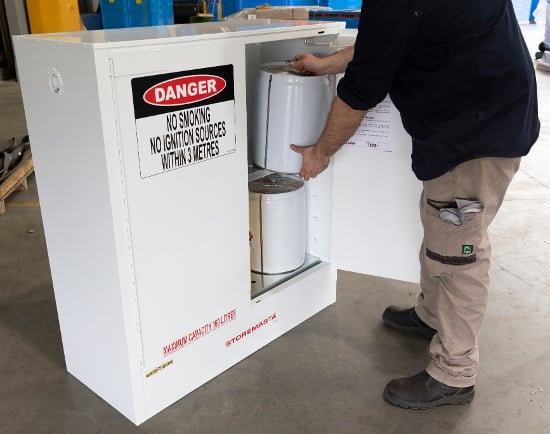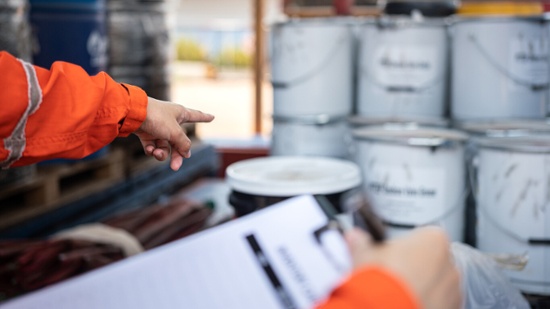As your Dangerous Goods Storage Specialists, we’ve seen our fair share of HAZCHEM stores. Most chemical stores are selected, installed, used and maintained to an excellent standard, but others may be missing vital safety measures that can protect staff, property and the surrounding environment.
In this post, we’ll be sharing our best tips for keeping your HAZCHEM store compliant. Some of these tips might seem like common sense, but you’d be surprised how often we find chemical safety cabinets or outdoor chemical storage containers failing to meet the most basic compliance requirements. Keep reading the blog to find out how to look after your HAZCHEM store and maintain compliance.
1. Only Store Hazardous Chemicals or Dangerous Goods
Sounds simple right? Only store chemicals in a safety cabinet or storage container.
However, we’ve seen many workplaces storing everything from personal protective equipment and tools to cleaning applicators and safety data sheets inside stores.
Make sure your staff are trained to understand how to store chemicals correctly and know not to put the following within a safety cabinet or dangerous goods container.
- Tools and applicators – don’t waste space in your chemical store by loading it with tools or applicators that can damage the cabinet, compromise containers, create a fire hazard or spark an incompatibility. Choose a dedicated tools storage facility for all your paint brushes, rags, mixing sticks, and rollers. Remember, many of these items are regarded as combustibles, so they can also add to the risk of fire when storing flammable liquids or solids.
- Personal protective equipment or safety equipment stored with chemicals – staff must be equipped with the correct personal protection equipment and safety equipment to reduce the risk of chemical exposure. However, you must never store any of these items – such as gloves or safety goggles – within a chemical cabinet or outdoor storage container. Keep your personal protective equipment in a PPE cabinet, to ensure safety and extend the lifespan of your equipment.
- Safety data sheets – while it’s necessary to have up-to-date safety data sheets close to each chemical cabinet or store, you must never store the SDS within the HAZCHEM store itself. We recommend using a safety data sheet folder, which is then stored within a SDS document holder attached to the cabinet or outdoor store.

Your stores, like this toxic substance storage cabinet, should only be for keeping that particular class of chemical.
2. Don’t Mix Dangerous Goods Classes
Once you’ve invested in a dedicated chemical store, don’t allow your staff to compromise their safety — and the compliance of your workplace — by storing mixed classes of chemicals together.
Instead, refer to the segregation rules detailed in the dangerous goods segregation chart, as well as the information for chemical storage found in the safety data sheet of your product.
One of the most common incompatibility problems we see with dangerous goods is when Class 8 Corrosive acids and bases are stored in the same chemical cabinet. These substances, while of the same DG class, must be stored separately for the safety of your workplace. There are many incompatible substances for each class of dangerous goods, so if you’re not sure of the segregation guidelines, then refer to a Dangerous Goods Consultant who can assist with compliant storage and segregation.
3. Have Consistent Work Procedures for Receiving Chemicals
While chemical stores may receive adequate attention from staff, have you considered the other areas in your operation that have chemical packages in the short term?
Your job site won’t be compliant if a stack of IBC’s containing Dangerous Goods is left sitting on the ground outside the warehouse. A chemical incident can easily occur when chemicals are being delivered or moved around your website.
To maintain safety, you’ll need consistent work procedures to ensure that every time an order of hazardous chemicals or dangerous goods is delivered, a sufficiently trained staff member is available to receive and put away the chemicals.
The order needs to be inspected for leaks and container damage, then put away in the chemical stores. A delivery left in the yard could be impacted by vehicles or compromised by unauthorised workers and site visitors. At the same time the chemicals may be exposed to heat and direct sunlight.
We also see chemical deliveries sitting in the yard without spill protection, which could spark a chemical reaction with incompatible substances, ignition of flammable chemicals or pollution of the environment due to a leak in the container.
Your work procedures should include purchasing controls to ensure there is always enough space in chemical stores to accommodate a delivery. Often, chemical deliveries are left outside because existing chemical stores are at capacity or there is no-one on shift with a forklift licence.

Unsafe practices can lead to hazards in outdoor areas and loading docks when chemicals aren’t put in storage when they first arrive on site.
4. Have Correct Warning Signs and Documentation
Chemical stores must have the appropriate dangerous goods and hazard signage according to Australian WHS Regulations, Safety Standards and the ADG Code (where applicable). This includes the warning placards placed on the safety cabinets themselves, as well as other signs that must be placed in and around the job site. You will not achieve chemical compliance if signs are damaged, installed at the wrong height, or have anything obstructing their visibility.
Many job sites have the correct storage equipment in place, but they fail to have copies of safety data sheets (sdss) and the register of hazardous chemicals available nearby. it’s very easy to resolve this problem by buying an SDS document holder, purpose-built for safety documents and attaching it within easy reach of the chemical stores.
5. Safely Dispose of Old Chemicals
Many workplaces we see have immaculate chemical stores, but then on a corner of the job site (or at the back of an old shed) we find a pile of discarded oil drums plus a bunch of unwanted chemicals. Very often this waste pile sits on old pallets (which are combustible) and contain a stack of ‘empty’ containers that still have traces of chemical liquids and fumes.
Unnecessary chemicals and empty containers should be disposed of safely to reduce hazards at your site. This includes the chemicals and containers that are no longer needed or those substances that are out-of-date.
In Australia, there are nationwide programs for the disposal of agricultural and veterinary (agvet) chemicals, and you can contact your local Council or EPA office for information about specific wastes including corrosives, solvents and toxic substances.
6. Have an Emergency Plan in Place
When you’re working with HAZCHEM, you must be prepared to deal with an emergency. One of the most important factors to consider is your emergency plan, associated documents, and staff training.
Make sure you have properly evaluated your onsite chemicals and HAZCHEM stores so that you can effectively create an emergency plan that addresses the risks in your workplace. Under model WHS laws, every workplace must have an emergency plan that is easy to access, reviewed and updated regularly. They must be developed and reviewed in consultation with the staff in your workplace.
Emergency plans must include essential information such as:
- Scope and application of the emergency plan
- Emergency contact list
- Roles and responsibilities of emergency management team
- How often and how the emergency plan is tested
- Staff training
- Reviewing, reporting and record-keeping
As a workplace with hazardous substances, remember to also implement the following:
- Register of hazardous chemicals – your register contains a complete list of all hazardous chemical stock at your site, as well as the safety data sheets. This register is a necessary document for emergency situations, as well as general chemical safety. Unlike the manifest, any quantity of hazardous chemicals must have a register.
- Manifest of hazardous chemicals – if you have manifest quantities of chemicals at your site, you’re obliged under WHS laws to provide a manifest of hazardous chemicals. The manifest is an essential component of your emergency plan. Keep your manifest in your HAZMAT box so emergency information can be quickly accessed.
- Evacuation routes – these should be well lit, free from items, clearly signposted and readily accessible. Never install safety cabinets or outdoor storage containers in an area which could impede evacuation during a chemical emergency.
- Hazchem code – as required by the Australian Dangerous Goods code, workplaces must have a Hazchem code which is an emergency action code of numbers and letters which supplies information to emergency services tending to your site.
HAZCHEM Compliance
The best way to determine if your worksite has any non-compliance issues is to conduct a risk assessment — including a site inspection and chemical safety audit. To get started, we recommend getting a copy of our free eBook. How to manage the risk of Hazardous Chemicals in the workplace clearly explains the risk assessment process so you can manage HAZCHEM store compliance. Download your copy today.

Living life by the 4 C’s of marketing – communication, coffee, compliance… and more coffee – Leisa Andersen is Storemasta’s Content Marketing Manager. When she’s not writing, you’ll find her enjoying all the good things in life, including shopping, travel and gluten free donuts.

